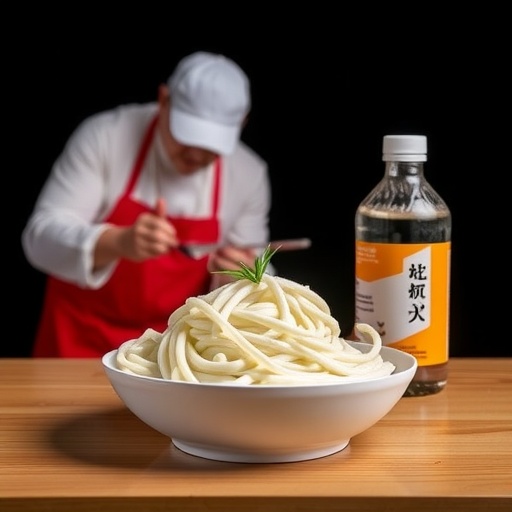In a groundbreaking study published in 2025, researchers Kim S.J. and Yoon K.S. have unveiled pioneering insights into the preservation and quality enhancement of Tteokbokki rice cake—one of Korea’s most beloved street foods—through the strategic use of acidulants combined with a novel antimicrobial agent, VERDAD N6. This research promises transformative implications for the food industry, particularly within the ready-to-eat sector, where maintaining freshness and safety without compromising sensory properties is a perpetual challenge.
Tteokbokki, a chewy, spicy rice cake dish commonly enjoyed across Korea and increasingly worldwide, has long struggled with microbiological spoilage issues that shorten shelf life and compromise food safety. The researchers set out to explore how acidulants—compounds that adjust pH levels—paired with the innovative compound VERDAD N6 could synergistically extend shelf life, preserve texture, and maintain the distinctive flavor profile that defines authentic Tteokbokki.
The team implemented rigorous experimental protocols to assess the microbiological and physicochemical changes in Tteokbokki samples treated with individual acidulants, VERDAD N6 alone, and various combinations thereof. They meticulously monitored bacterial populations, pH dynamics, moisture activity, and texture consistency over multiple storage intervals, mimicking real-world refrigeration and ambient conditions to understand practical applications.
.adsslot_MrChYPRKGX{ width:728px !important; height:90px !important; }
@media (max-width:1199px) { .adsslot_MrChYPRKGX{ width:468px !important; height:60px !important; } }
@media (max-width:767px) { .adsslot_MrChYPRKGX{ width:320px !important; height:50px !important; } }
ADVERTISEMENT
One key finding was the potent antimicrobial effect observed when VERDAD N6 was paired with acidulants such as lactic acid or citric acid. This combination significantly inhibited the growth of spoilage microorganisms and common foodborne pathogens, thereby reducing the risk of food deterioration and enhancing overall safety. The acidulants alone lowered pH but were less effective at restricting microbial growth, highlighting the importance of the synergistic action.
Physicochemical properties, including moisture retention and textural integrity, were closely examined through instrumental analyses such as texture profile analysis (TPA) and water activity measurements. The integration of VERDAD N6 with select acidulants preserved the characteristic chewiness and resilience of Tteokbokki, counteracting common problems like hardening or sogginess that often afflict stored rice cakes.
From a biochemical perspective, the research illuminated how the acidulant modifies the microenvironment within the rice cake matrix, enhancing the antimicrobial efficacy of VERDAD N6. This interaction may disrupt microbial cell membranes more efficiently under acidic conditions, though the authors call for further molecular-level studies to fully elucidate the mechanisms at play.
Notably, treatments did not negatively impact the organoleptic properties critical to consumer acceptance. Sensory panels reported that the acidity levels and textural modifications remained within acceptable ranges, preserving the traditional taste and mouthfeel that define consumer loyalty to Tteokbokki. This balance between preservation and palatability is essential for commercial scalability.
The implications extend beyond just Tteokbokki, as this evidence supports broader utilization of combined acidulant and antimicrobial strategies in diverse starch-based and fermented food products. The findings introduce a model for improving food safety without relying on synthetic preservatives that might evoke consumer apprehension or regulatory hurdles.
Furthermore, VERDAD N6 appears to be a promising candidate in the push towards cleaner labels and natural preservative solutions. Its compatibility with food-grade acidulants suggests potential utility across a range of culinary contexts where shelf life extension meets emerging demands for minimal processing and natural additives.
The research also contributes to sustainable food practices by potentially reducing food waste. Extended shelf life enables longer distribution channels and diminishes spoilage-related discard, aligning with global sustainability goals surrounding food security and responsible consumption.
Kim and Yoon’s approach underscores the importance of comprehensive assessment protocols that consider microbiological dynamics alongside physicochemical traits—factors often studied in isolation. Their integrated methodology sets a precedent for future food science investigations aiming to optimize multiple quality parameters simultaneously.
Anticipated follow-up studies are likely to explore the molecular interactions between VERDAD N6 components and microbial pathways, seeking to maximize efficacy while ensuring safety and compliance with food regulations worldwide. Such explorations could open doors to customizing preservative blends tailored to specific food matrices.
Moreover, the interaction between acidity and antimicrobial agents at the nano- or micro-scale hints at innovative delivery systems that might control release rates or target microbial populations more precisely. This intersection of food chemistry and emerging nanotechnologies could redefine preservation science.
The research also raises important questions regarding consumer perception and market acceptance. The nuanced balance between preserving traditional food qualities and introducing novel additives must be navigated carefully through transparent communication and rigorous safety validations.
Given the widespread popularity of Korean cuisine, and the growing global market for convenient ethnic foods, the ability to reliably maintain Tteokbokki’s freshness post-production is both a commercial boon and a public health asset. The study effectively positions VERDAD N6 as a groundbreaking tool in this expansion.
Finally, these insights reflect a broader trend in food biotechnology emphasizing synergy—combining multiple agents to achieve optimized preservation outcomes while preserving sensory attributes and ensuring food safety. This multi-pronged approach may soon characterize state-of-the-art food preservation protocols across industries.
As consumers increasingly demand foods that are safe, fresh, and authentic, innovations like the use of acidulants paired with VERDAD N6 in Tteokbokki provide a compelling blueprint for meeting such complex challenges. This research exemplifies how targeted chemical and biological interventions can revitalize traditional foods for the modern marketplace.
Subject of Research: The microbiological and physicochemical effects of acidulants combined with VERDAD N6 on Tteokbokki rice cake preservation.
Article Title: The combined effects of acidulant and VERDAD N6 on the microbiological and physicochemical properties of Tteokbokki rice cake.
Article References:
Kim, S.J., Yoon, K.S. The combined effects of acidulant and VERDAD N6 on the microbiological and physicochemical properties of Tteokbokki rice cake. Food Sci Biotechnol (2025). https://doi.org/10.1007/s10068-025-01979-9
Image Credits: AI Generated
DOI: https://doi.org/10.1007/s10068-025-01979-9
Tags: acidulants in food safetyenhancing shelf life of street foodexperimental protocols in food researchfood industry quality enhancementmicrobiological spoilage in TteokbokkipH adjustment in food productsphysicochemical changes in rice cakesready-to-eat food innovationsrice cake texture preservationsensory properties of TteokbokkiTteokbokki preservation techniquesVERDAD N6 antimicrobial properties





